Our Work: 2015
Our Work - 2015
Safer food saves lives
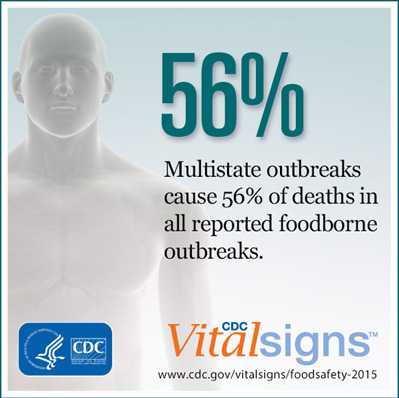
The November Vital Signs focused on investigating and stopping multistate foodborne outbreaks. From 2010 to 2014, multistate outbreaks caused 56% of deaths in all reported foodborne outbreaks despite accounting for just 3% of outbreaks. Foods involved in multistate outbreaks are contaminated before they reach a restaurant or home kitchen. Investigating these outbreaks often reveals problems on the farm, during processing or in distribution that resulted in contaminated food. To help improve detection of and response to these outbreaks, the report outlines specific actions such as the following: food industries should keep detailed records to allow faster tracing of foods from source to destination; state and local agencies should interview sick people promptly about what they ate; healthcare providers should rapidly submit specimens from sick people to public health laboratories for advanced testing; and consumers should check for information about food recalls and safe food handling and preparation.
Two recent E. coli outbreaks traced to food from retailers are multistate outbreaks. CDC, FDA, and several states have been investigating a multistate outbreak of Shiga toxin-producing E. coli O26 (STEC O26) infections linked to eating at multiple locations of Chipotle Mexican Grill. As of December 4, a total of 52 ill people have been reported from 9 states. Twenty have been hospitalized, and there have been no reports of hemolytic uremic syndrome or deaths.
The outbreak was initially detected by public health officials in Washington and Oregon through local foodborne disease surveillance. Officials in Washington and Oregon detected an increase in STEC infections in their states and after interviews with ill people they determined illness was likely linked to eating at multiple Chipotle locations. Once DNA fingerprinting had been completed, CDC determined that several illnesses in states other than Washington and Oregon had occurred during the same period. Whole genome sequencing also provided genetic information linking cases in multiple states. The epidemiologic evidence available at this time suggests that a common meal item or ingredient served at the restaurants is a likely source of the outbreak; the ongoing investigation has not identified the specific food linked to illness. Chipotle is assisting public health officials with understanding the distribution of food items served at locations where ill people ate.
Just before Thanksgiving, CDC, FDA, USDA’s Food Safety and Inspection Service (FSIS), and state and local health officials in several states collaborated to investigate yet another multistate foodborne disease outbreak, this one involving E. coli O157:H7 infections in people who had eaten rotisserie chicken salad purchased from Costco stores. As of December 8, a total of 19 people have been sickened in 7 states, and 5 have been hospitalized. Preliminary laboratory results indicated the presence of E. coli O157:H7 in a celery and onion diced blend used in the chicken salad and supplied by Taylor Farms Pacific, Inc. As a result, the company voluntarily recalled multiple products containing celery because they may be contaminated. According to FDA, additional laboratory analysis of a sample of celery/onion blend did not confirm the presence of E. coli O157:H7 in the sample, and the investigation is working which specific ingredient in the chicken salad is linked to illness. The celery and onion diced blend has not been ruled out as a source of the outbreak. No additional illnesses linked to this outbreak have been reported to CDC since November 23.
Dengue outbreak in Hawaii
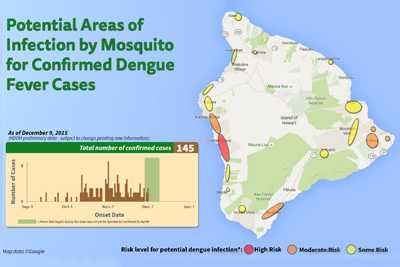
CDC is assisting the Hawaii Department of Health (DOH) in the response to an outbreak of dengue on the Big Island. As of December 9, there have been 145 confirmed cases of dengue. Dengue is not endemic to the island, but it is intermittently imported from disease-endemic areas by infected travelers. This is the first outbreak of locally acquired dengue in the state since 2011. CDC is providing diagnostic assistance to the Hawaii DOH in confirming dengue cases. At the request of Hawaii’s governor, CDC staff traveled to Hawaii to assist with the investigation and outbreak response.
Get Smart about Antibiotics Week
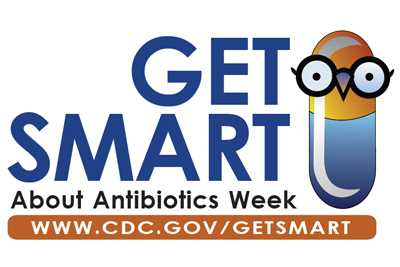
Backed for the first time by a Presidential Proclamation, Get Smart About Antibiotics Week (November 16-22) aimed to raise awareness about the threat of antibiotic resistance and promote appropriate antibiotic prescribing and use. This year’s rollout involved science, communications, and CDC policy experts. With 130 partners in 2015, this year’s Get Smart Week included:
- New CDC data maps about antibiotic prescribing rates in US health provider offices and antibiotic stewardship programs by state
- Stewardship activities from partners like Walmart, Consumer Reports, and the Hospital Corporation of America
Ebola update
Status in West Africa

The situation in West Africa continues to evolve. On November 7, Sierra Leone reached a major milestone in its fight against Ebola – after more than 14,000 reported cases and nearly 4,000 deaths, WHO declared the country free of Ebola virus transmission. Additionally, as of December 7 Guinea had not reported a confirmed case of Ebola since October 29. The last known patient with Ebola tested negative on November 16, and the country’s 42-day countdown to being declared free of transmission began on November 17.
Despite the progress, it’s clear that we cannot let our guard down. On November 19, Liberia identified three new confirmed cases of Ebola. We also know that Ebola virus sometimes persists in certain parts of the body after someone recovers from the disease – and we continue to learn more about this phenomenon. As we look toward 2016, we need to make sure each of these countries is equipped to prevent, detect, and rapidly respond to any new cases. This means educating and supporting survivors, as well as maintaining and strengthening the health infrastructure.
New Ebola assays deployed
Two new tests—the CDC Ebola virus NP real-time RT-PCR assay and CDC Ebola virus VP40 real-time RT-PCR assay—have just been deployed to Ebola testing laboratories in the Laboratory Response Network (LRN). The assays have been authorized for emergency use by the US Food and Drug Administration (FDA). Use of these two assays in conjunction with the algorithm in the LRN Guidance for Definitive Identification of Ebola Virus in Patient Specimens will help speed case confirmation and reduce the risk of false-positive results in vaccinated individuals.
Foodborne outbreak tool just launched

The Foodborne Outbreak Online Database Tool (FOOD Tool) will make it easier to search data on foodborne disease outbreaks. The tool includes interactive features such as maps, graphs and tables. Users can search nearly 20 years of outbreak data (1998-2014) by state, food, or pathogen. New features also allow users to search data by specific foods and ingredients, view a “quick stats” display, and get case counts for multistate outbreaks. Users can search foodborne disease data by many factors, including year, state, location of food preparation, food and ingredient, and cause of illness. Public health investigators can use the database to help point them toward possible sources of foodborne illness by searching foods implicated in past outbreaks. Because the database contains information only on foodborne disease outbreaks reported to CDC, guidance on using the data and limitations to keep in mind when searching by food or ingredient is also provided.
New NCEZID publication highlights emerging technologies

CDC released a new publication that profiles fascinating new tests and tools that have been developed to help us better protect people from ever-changing infectious disease threats. Innovative Technologies (also available in print) looks at a wide range of innovations and improvements in diagnostics (for dengue, yellow fever, and invasive candidiasis) and vaccines (rabies and human papillomavirus). Also featured are improved ways of connecting scientists with CDC’s infectious disease expertise. For example, ePathology is a new platform that connects NCEZID pathologists with scientists anywhere in the world, and recent improvements to MicrobeNet make that system an easier-to-access tool. Innovative Technologies also showcases new solutions designed to address large-scale problems like Ebola, antibiotic resistance, and influenza. Among the novel technologies spotlighted are lab innovations that were created to curb the Ebola epidemic, how NCEZID scientists are providing the “raw material” to help pharmaceutical companies and diagnostic manufacturers develop new antibiotics and tests to slow antibiotic resistance, and a look at how video analysis could be used to more accurately describe how flu spreads.
Ebola Update

We continue to learn more about Ebola, as evidenced by an October report published in the New England Journal of Medicine describing a study done in collaboration between the Sierra Leone Ministry of Health and Sanitation, the World Health Organization, and CDC. In a preliminary study of semen samples obtained from Ebola survivors in Sierra Leone, Ebola virus fragments were detected up to 9 months following the onset of the illness. The virus fragments were detected using a quantitative RT-PCR assay looking for the sequences of two Ebola virus genes (NP and VP40). Semen samples from 93 Ebola survivors were analyzed, of which 46 (49%) samples were positive for the Ebola virus RNA. Whether these viral fragments represent infectious virus able to cause new infections is not yet known. The men were informed of their results, provided condoms, and educated about how to protect their partners. NCEZID researchers are now analyzing the samples to determine whether the remaining virus is capable of causing new infections. These results highlight the need for continued research as well as for education and support for the survivors of Ebola and their communities.
Dietary supplements and emergency department visits

Many people in the United States take dietary supplements, and until now we have not had any national data on the adverse effects related to these products. Thanks to a new CDC study published in the New England Journal of Medicine, we now know that about 23,000 emergency department visits are attributed to adverse events related to dietary supplements each year in this country. Among young adults, the most common reason for these visits was for cardiovascular symptoms after they took weight-loss or energy products. Among older adults, the most common reason for visits was swallowing problems because of the size of pills. The study also received extensive media coverage, including stories by Reuters, UPI, and the New York Times.
Stopping the spread of antibiotic resistance
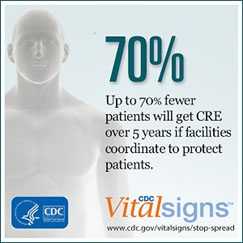
CDC’s August Vital Signs shows that with effective action now, including nationwide antibiotic stewardship efforts and interventions to prevent spread of antibiotic-resistant infections, an estimated 619,000 resistant and Clostridium difficile infections, and 37,000 deaths among infected patients might be averted nationally over the next 5 years. Antibiotic-resistant bacteria can spread inside of and between health care facilities when patients transfer from 1 health care facility to another for care without appropriate infection control actions in place. The report outlines the importance of facilities and health departments working together in a coordinated approach to stop the spread of infections and slow antibiotic resistance.
As part of its release, CDC’s Division of Healthcare Quality Promotion:
- Received media coverage from major sources, including Fox News, USA Today, Web MD, Washington Post, CNN, Forbes, Cidrap, LA Times.
- Hosted more than 18 calls with partners before the launch, including hospital associations, patient advocates, state partners, and White House Forum attendees who further amplified reach
- Developed a variety of communications materials, including the fact sheet, , social media messaging, and Safe Healthcare blogs
- Presented at a virtual Vital Signs Town Hall with state health departments and conducted a COCA webinar for clinicians with record attendance of more than 2,709 audio lines and 850 webinar lines accessed
This edition of Vital Signs focusing on antibiotic resistance made innovative use of modeling to help focus efforts to stop one of the most serious public health threats of our time. The goal of Vital Signs is to communicate science into actionable recommendations that resonate with CDC audiences.
NARMS Now: Human Data

NCEZID’s new interactive tool, NARMS Now: Human Data, allows users to view trends in antibiotic resistance over the past 18 years for 4 bacteria transmitted commonly through food: Campylobacter, E. coli O157, Salmonella, and Shigella. Antibiotic-resistant infections from bacteria transmitted commonly through food cause an estimated 440,000 illnesses in the United States each year. The tool, which contains antibiotic resistance data from bacteria isolated from humans as part of the National Antimicrobial Resistance Monitoring System (NARMS), allows you to search data by bacterial serotype, antibiotic, year (1996-2013), and geographic region. The data can be viewed on interactive maps and graphics or in tables. Use the data to see resistance trends, geographic variances in resistance, and more.
Increased plague activity
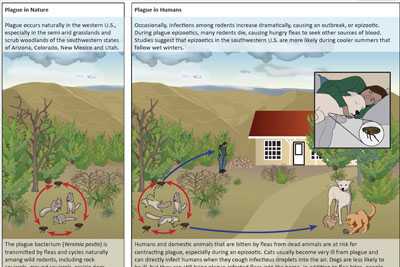
NCEZID staff have been actively responding to an uptick in plague activity throughout the western United States. As of August 31, there have been 12 cases (4 fatal), with 2 cases linked to exposures in or near Yosemite National Park. The most recent case was confirmed by health authorities in Utah on August 28. From 2001 to 2012, the annual number of plague cases in humans ranged 1 to 17 (median = 3 cases). It’s not clear why we’re seeing a higher-than-usual number of cases in 2015. For more information see the recent MMWR article (published before the report of the Utah case).
Increased plague activity
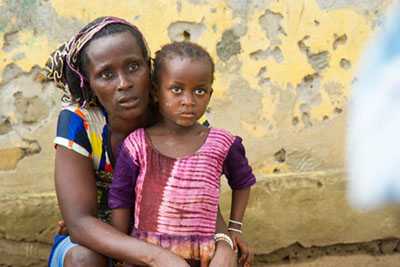
The outlook for controlling the Ebola epidemic continues to improve. As of August 31, no new cases have been reported in Liberia following the cluster of 6 cases that occurred in July. The last 2 patients in Liberia were discharged on July 23, and all contacts in the country have now completed their 21-day monitoring period. It’s also good to report that there have been no infections in healthcare workers for 3 consecutive weeks in Liberia, Sierra Leone, or Guinea. Although the outbreak has slowed dramatically from where we were a year ago, there is still much to do. There are now thousands of Ebola survivors – more than we’ve ever seen before – who will need medical, psychological, and community support long after the epidemic has ended.
Ebola Update
July 9 marked 1 year since CDC’s emergency activation for Ebola. This is the largest outbreak response in CDC’s history – larger in scale and scope than any other before. More than 1,200 responders, many of them from NCEZID, have deployed to Guinea, Liberia, Sierra Leone, and surrounding countries in West Africa. To commemorate the first year of the response, CDC released a multimedia report documenting the efforts of the agency and its partners in fighting the outbreak, told through the stories and photos of our responders. The website, video, and photobook offer a poignant look at how CDC staff have contributed to this response over the past year. It’s a terrific multimedia summation of the year-long response.
Despite the progress that’s been made, there is still much to be done. On June 29, Liberia reported a new confirmed case, its first since March 20, and five more cases had been reported as of July 25. This shows us how difficult it is for a country to stay at zero cases and underscores the need for continued vigilance, meticulous contact tracing and other support for the affected countries. Certainly the progress made over the past year in Liberia, Guinea, and Sierra Leone, including establishing emergency operations centers, improved laboratory capacity, and strengthened surveillance, aids in the ongoing effort.
Salmonella outbreaks in frozen stuffed chicken entrees

Our colleagues in DFWED are also working with several states and USDA’s Food Safety and Inspection Service to investigate 2 separate outbreaks of Salmonella Enteritidis infections linked to raw, frozen, stuffed chicken entrees, such as chicken Kiev and chicken cordon bleu. The 2 outbreaks are caused by different strains of Salmonella Enteritidis. As of July 29, the outbreak linked to consuming frozen chicken entrees produced by Barber Foods has involved 9 ill people in 4 states. The other outbreak, involving 3 ill people in Minnesota, is linked to consuming frozen chicken entrees produced by Aspen Foods. As a result of the two investigations, Barber Foods and Aspen Foods each issued separate recalls of raw frozen chicken products totaling almost 4 million pounds.
It’s quite unusual for companies to recall raw poultry products for Salmonella that is not multidrug-resistant and that has not caused a large outbreak. Contributing factors include the fact that the product looks cooked but is actually raw; that the package labeling is already very clear in warning consumers that the product is not cooked; that there is a history of many previous outbreaks due to similar products; and that whole genome sequencing (WGS) very closely linked the isolates from this product and the ill people who ate it. This may be a first according to our DFWED experts.
This also is a look into the future of how Salmonella outbreaks will be investigated. Right now, only Minnesota and New York use WGS plus detailed interviews to investigate outbreaks of Salmonella Enteritidis infections. Over the next few years, as WGS-based surveillance for Salmonella expands to other states—many of which interview case patients in detail—we can expect to find many more clusters and outbreaks for Salmonella, similar to what is now happening for Listeria.
This also is a look into the future of how Salmonella outbreaks will be investigated. Right now, only Minnesota and New York use WGS plus detailed interviews to investigate outbreaks of Salmonella Enteritidis infections. Over the next few years, as WGS-based surveillance for Salmonella expands to other states—many of which interview case patients in detail—we can expect to find many more clusters and outbreaks for Salmonella, similar to what is now happening for Listeria.
2016 update to the ultimate guide for healthy international travel
CDC has released the 2016 edition of CDC Health Information for International Travel, commonly known as the Yellow Book. Nicknamed for its yellow cover, the updated book is the ultimate guide for healthy international travel. The most recent version includes updated sections on emerging global diseases, including Ebola, MERS, and chikungunya.
The 2016 edition also features expanded guidelines for 16 popular travel destinations, including Brazil, Cambodia, Dominican Republic, and Haiti. Also new features, such as yellow fever vaccination recommendation maps for 10 countries and comprehensive advice for health care workers traveling overseas, have been included. The content of the Yellow Book is available at CDC’s Travelers’ Health website, www.cdc.gov/travel. Print versions can be ordered directly from Oxford University Press or from most major online booksellers.
Rare infection in immunocompromised patients in Colorado

Three Epidemic Intelligence Service (EIS) officers from CDC went to Denver, Colorado, to assist the Colorado Department of Public Health and Environment with an investigation of mucormycosis in immunocompromised patients. Mucormycosis is a rare, often fatal fungal infection, caused by a group of angioinvasive molds. This investigation stems from the health department’s reports earlier this year about a cluster of mucormycosis infections among bone marrow transplant patients in a Colorado hospital. The EIS officers are searching for possible common sources of infections by conducting hypothesis generation interviews and analyzing abstracted clinical data. If they identify a strong hypothesis, they will assist in an analytical epidemiological study to test the hypothesis. In addition, they aim to identify any breeches in infection prevention measures.
Leaders meet at White House to combat antibiotic resistance
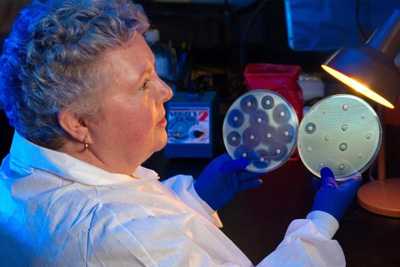
What does antibiotic resistance look like? A CDC microbiologist holds two Petri dish culture plates growing bacteria. In this case, the bacteria on the left are susceptible to the antibiotics, meaning they cannot grow. On the right, however, the bacteria are resistant to the antibiotics, meaning they are able to grow next to almost all of the antibiotics tested.
Leaders from private industry and human and animal health organizations across the country joined CDC and other federal agencies at the to discuss the growing problem of antibiotic resistance . Organizations made specific commitments to combat the emergence of resistant bacteria, protect antibiotics, and prevent a future where simple infections might kill because we have no way to treat them.
CDC Director Dr. Thomas Frieden opened the forum by leading a discussion with five of the committing companies—representing hospitals, nursing homes, animal pharmaceuticals, and food producers and retailers—about the business case for improving how we use and prescribe antibiotics. Attendees were then split into two breakout sessions (human and animal health) to discuss opportunities and barriers to implementing antibiotic stewardship principles across US industry. The event was featured in a Wall Street Journal op-ed and generated 9-times more views of the CDC’s Antibiotic Resistance Solutions Initiative webpage (versus a typical day). And the media attention around antibiotic resistance continues to grow, as witnessed by Consumer Report’s recent online report, “The Rise of Superbugs,” the first of a 3-part examination titled “America’s Antibiotic Crisis.” By the end of the day-long forum, many health and business leaders had pledged to take immediate action to turn the tide on antibiotic resistance.
CDC responds to MERS
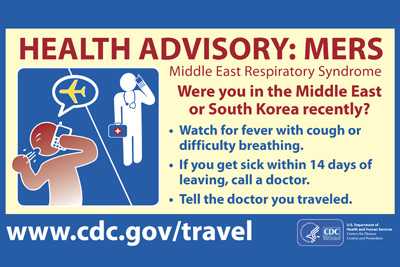
Centers across CDC are working together in response to the outbreak of Middle East Respiratory Syndrome (MERS) in the Republic of Korea, which reported its first laboratory-confirmed case on May 20. As of June 25, a total of 180 cases (including 29 deaths) have been confirmed in the Republic of Korea by the World Health Organization, all linked to healthcare facilities where patients with MERS were treated. One of these cases is a contact associated with the outbreak who traveled to China while symptomatic. It’s the largest known outbreak of MERS outside the Arabian Peninsula, where a Level 2 Alert, Practice Enhanced Precautions has been in place since May 14.
CDC also posted a Level 1 Watch, Practice Usual Precautions for the Republic of Korea on June 11, which includes a new infographic in Korean and English with guidance for travelers to the country. Other activities include posting a Hajj/Umrah travel notice before the 2015 Ramadan travel season begins, displaying MERS messages for inbound travelers on electronic message boards in arrival areas in international airports, and updating US Customs and Border Protection materials to add information about the outbreak in the Republic of Korea.
CDC’s infection control experts contributed to the recently updated interim infection control recommendations for hospitalized patients with MERS and disseminated them widely through the MERS website, social media, extensive partner distribution lists, a Health Alert Network (HAN) Advisory, and a Clinician Outreach and Communication Activity (COCA) call with healthcare providers around the nation. In addition to continued emphasis on standard, contact, and airborne precautions, the guidance underscores other elements of infection control programs that should be in place to prevent the spread of infectious agents. Preventing virus transmission in hospitals with MERS patients is a vital piece of the MERS response strategy.
How to treat Rocky Mountain spotted fever

CDC has been involved in raising awareness about how to safely and effectively treat Rocky Mountain spotted fever (RMSF). A new study , conducted by CDC and Indian Health Service, found that short courses of the antibiotic doxycycline (the most effective antibiotic for treating suspected RMSF infections) can be used in children without causing tooth staining or weakening of tooth enamel. Countering misperceptions about the use of doxycycline for children helps kids get lifesaving treatment, which is especially important because children are 5 times as likely to die of RMSF than any age group.
An accompanying Journal of Pediatrics commentary, a Medscape expert commentary and a new web page have been created to reinforce this important public health message. Another study published in June in The American Journal of Tropical Medicine and Hygiene focused on the cost savings that could result from prevention and early treatment of RMSF in Arizona. The authors estimated that $13.2 million in losses was linked to the epidemic of RMSF on two Indian reservations during 2002–2011.
Rabies confirmed in dog imported from Egypt

The rabid dog’s reportedly falsified vaccination documents.
On June 10, CDC’s Poxvirus and Rabies Branch confirmed the diagnosis of rabies in a dog imported from Cairo, Egypt. In total, 18 US citizens (Virginia residents) have been started on rabies post-exposure prophylaxis due to contact with the rabid dog. Human and animal exposure investigations have been completed at the state level. A review is underway to determine how this infected dog was able to enter the United States.
Ebola Update

On May 9, CDC and its international partners celebrated a major achievement in the Ebola response as Liberia’s outbreak was officially declared over by the World Health Organization. This date marked 42 days (two incubation periods) since the last known Ebola patient in the country was buried. Public health authorities in Liberia continue to maintain active surveillance so that any new cases of Ebola are rapidly identified. This milestone followed CDC’s downgrading of Liberia’s Travel Health Notice from a Warning – Level 3 to an Alert – Level 2 on May 4. US residents are no longer advised to avoid nonessential travel to Liberia, but CDC still recommends they practice enhanced precautions while there. We remain committed to helping Liberia stay at zero cases, but we still have much work to do to get Guinea and Sierra Leone to the same point.
As of May 24, there have been 27,013 total suspected, probable, and confirmed cases of Ebola reported worldwide. Of those, 14,969 cases are confirmed, and deaths from the disease now stand at 11,134. In Guinea, considerable challenges still remain. In Sierra Leone, there are fewer cases, and those that occur are coming from recognized chains of transmission. Our team is meticulously tracing and appropriately isolating and following contacts of these cases.
The Sierra Leone Trial to Introduce a Vaccine against Ebola (STRIVE) was successfully launched in April to assess the safety of the candidate Ebola vaccine rVSV-ZEBOV. As of May 24, over 4,350 participants have enrolled and over 2,100 have been vaccinated.
Staying healthy and safe in the water

With swimming pools about to open for the summer, CDC’s Waterborne Diseases Prevention Branch is hard at work educating the public about how to enjoy swimming while decreasing the risk of getting sick with waterborne diseases. An MMWR report on May 18 reported on a lake-based norovirus disease outbreak last year that sickened 70 people, more than half of them children. The authors found that people who swam were more than twice as likely to become ill than those who went to the lake but did not swim. The report coincided with Healthy and Safe Swimming Week (May 18-24), the theme of which was “Make a Healthy Splash: Share the Fun, not the Germs.” The Waterborne branch developed a healthy swimming brochure and is promoting their healthy swimming website and health promotion toolkit for health department partners with simple tips to keep everyone healthy. Take a few minutes to check out the website before you or your loved ones hit the pool this summer!
Annual Food Safety Progress Report
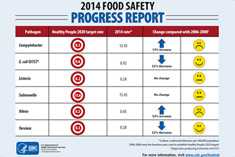
This year’s annual food safety progress report showed that rates of infection from E. coli 0157 and Salmonella Typhimurium (one of the more common serotypes) decreased compared with the baseline period of 2006–2008. Meanwhile, some other less common types of Salmonella increased, Campylobacter and Vibrio rose again in 2014, and 6 other infections showed little or no recent improvements. The yearly report measures foodborne illnesses from 9 key pathogens and is produced from 2014 data compiled by the Foodborne Diseases Active Surveillance Network (FoodNet).
New rabies strain identified in New Mexico

The New Mexico Department of Health asked DHCPP’s Rabies Lab to assist in the identification of rabies after a woman was bitten by a rabid fox in Lincoln County, NM. Genetic sequencing of the virus done by CDC’s Rabies Lab showed that this was a rabies virus strain never before identified. The new strain is related to other rabies strains found in bats. The woman received a series of rabies vaccinations that protected her from rabies.
Ebola Update
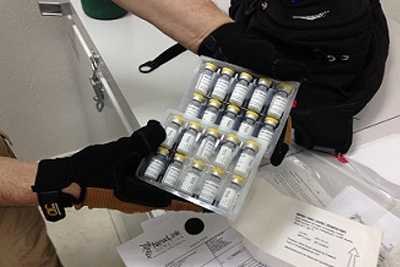
With cases continuing to be reported in Guinea and Sierra Leone, and a total case count now surpassing 26,000, CDC’s work on the Ebola response is still far from over. Liberia’s last known patient with Ebola died on March 27, and we are now counting down to the day Liberia will be declared free of Ebola. We continue to focus on improving the situation in Guinea and Sierra Leone, where more needs to be done to identify and break all chains of transmission.
Laboratory diagnostics
Work continues on the evaluation and roll-out of a rapid diagnostic test for Ebola for use in country and on the long-term planning for transitioning to a sustainable public health laboratory system.
Vaccine trial starts in Sierra Leone
CDC and its partners in Sierra Leone are working together on a candidate Ebola vaccine trial , which officially launched in April 2015. The study, called the Sierra Leone Trial to Introduce a Vaccine Against Ebola (STRIVE), will assess the safety and efficacy of a candidate Ebola vaccine in about 6,000 health and other frontline workers in five districts in Sierra Leone.
Listeria contamination results in voluntary recall of all Blue Bell products

CDC, state and local health departments, and the U.S. Food and Drug Administration are investigating a complex multistate outbreak of listeriosis linked to Blue Bell brand products. As of April 21, Blue Bell ice cream has been linked to Listeria illnesses in 10 people, 3 of whom died. The illness onset dates ranged from 2010 through 2015, and a review of the PulseNet database and whole genome sequencing data helped investigators link the illnesses to Blue Bell ice cream.
On April 20, Blue Bell Creameries voluntarily recalled all of its products currently on the market, including ice cream, frozen yogurt, sherbet, and frozen snacks, because they may be contaminated with Listeria monocytogenes. CDC recommends consumers do not eat any Blue Bell brand products and that institutions and retailers do not serve or sell them.
Multidrug-resistant shigellosis spreading in the US

International travelers are bringing a multidrug-resistant intestinal illness to the United States and spreading it to others who have not traveled, according to an MMWR report released this month that received a lot of media attention. Shigella sonnei bacteria resistant to the antibiotic ciprofloxacin sickened 243 people in 32 states and Puerto Rico between May 2014 and February 2015. Research by NCEZID found that the drug-resistant illness was being repeatedly introduced as ill travelers returned and was then infecting other people in a series of outbreaks around the country. “The increase in drug-resistant Shigella makes it even more critical to prevent shigellosis from spreading,” said Anna Bowen, medical officer and lead author of the study. “Washing your hands with soap and water is important for everyone. Also, international travelers can protect themselves by choosing hot foods and drinking only from sealed containers.”
Ebola Update
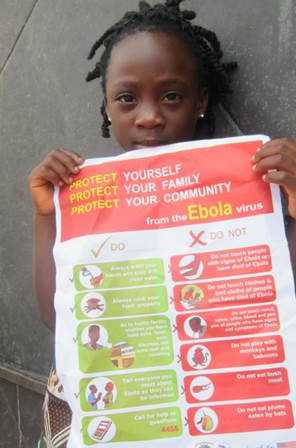
In Liberia, a new patient tested positive for Ebola not long after the country had started its countdown to being free of transmission. Teams are actively engaged in tracing and following contacts. New cases continue to be reported in Guinea and Sierra Leone, but considerable progress is being made in both countries.
As long as there are cases in West Africa, Ebola remains a global threat. We recently saw one American health worker evacuated to the United States for treatment after contracting Ebola in Sierra Leone, bringing the total number of patients treated here for Ebola to 11. Several other potentially exposed American citizens were also transported from Sierra Leone and will remain near Ebola treatment centers throughout the country during their 21-day monitoring period. We will not stop until we cases.
CDC is working with the Sierra Leone College of Medicine and Allied Health Sciences and the Sierra Leone Ministry of Health and Sanitation to launch a candidate Ebola vaccine trial in Sierra Leone that is anticipated to start in early April. The study, called the Sierra Leone Trial to Introduce a Vaccine against Ebola ( STRIVE ), plans to assess the safety and efficacy of a candidate Ebola vaccine (rVSV-ZEBOV) among health and other frontline workers in Sierra Leone.
Updated TB screening guidelines identify more cases overseas
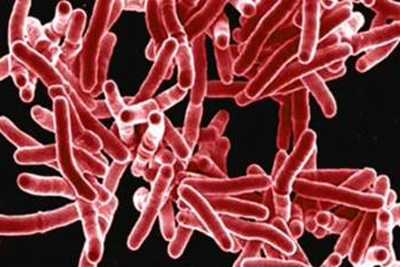
A new study by DGMQ authors just published in the Annals of Internal Medicine (abstract: Effect of a Culture-Based Screening Algorithm on Tuberculosis Incidence in Immigrants and Refugees Bound for the United States: A Population-Based Cross-sectional Study ) shows that because of new TB screening guidelines issued in 2007, physicians overseas identified 629 additional cases of tuberculosis (TB) in 2012 among immigrants and refugees bound for the United States. With implementation in all countries having been completed, physicians overseas should continue to identify more than 600 additional cases of tuberculosis each year as compared with yields prior to 2007. This makes this effort one of the largest and most successful interventions for U.S. TB control in the past decade. The results of this study showed that the updated overseas screening guidelines led to a roughly one-third decrease in the number of TB cases among foreign-born persons within their first year in the United States.
CRE infections related to duodenoscopes

In response to recent outbreaks of CRE (carbapenem-resistant Enterobacteriaceae) related to a type of endoscope called a duodenoscope, CDC, with input from healthcare facilities and others, has developed an interim protocol for facilities that want to test their duodenoscopes for contamination after the cleaning and disinfection process. The fact that recent outbreaks have occurred without identified lapses of infection control is a call for action. CDC is working with partners, including the U.S. Food and Drug Administration, medical specialty societies, subject matter experts, and state and local health departments to further understand and address the possibility of bacteria transmission related to duodenoscopes.
A new poxvirus in Eastern Europe
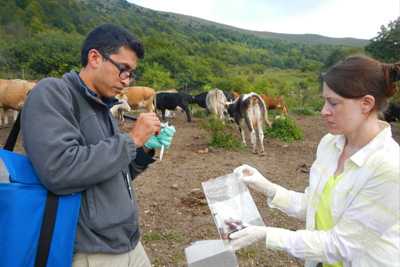
NCEZID staff have published a report of the discovery of a novel Orthopoxvirus species in the country of Georgia. The paper, which appeared in the New England Journal of Medicine (abstract: Human infection with a zoonotic orthopoxvirus in the country of Georgia. )this month, outlines the investigation between CDC and Georgian health officials into two men who had skin lesions originally thought to be cowpox. Further testing, including whole genome sequencing, led to the discovery that the virus is a novel species. Retrospective review of archived human specimens led to the discovery of a third case dating back to 2010. Available evidence suggests that the virus is zoonotic – the men had had contact with sick cows prior to becoming ill. More surveillance and study will be needed to learn more about this new virus and what public health interventions may be needed in the future.
Getting to zero in Guinea, Liberia, and Sierra Leone

While recent declines in new Ebola cases in some areas of West Africa have been encouraging, we’re seeing such a different scenario in each of the affected countries. In Liberia, there’s been considerable progress and we’re tracking what appears to be the last remaining transmission cluster of Ebola cases. In Sierra Leone, there are still many cases of disease but also considerable progress in terms of rapid identification of cases and contact tracing. In Guinea, the situation remains challenging, with additional staffing and other capacity needs and communities continuing to resist response measures.
Here in the United States, CDC staff have helped in many ways to enhance domestic preparedness for Ebola. Entry screening and active monitoring help ensure prompt detection of anyone who may have Ebola symptoms, and CDC has given out more than 7,200 CARE Kits to travelers entering the United States from Guinea, Liberia, and Sierra Leone to help them perform daily health checks. Our healthcare system is more prepared than ever to identify, isolate, and treat an Ebola patient. The Laboratory Response Network has more than quadrupled its laboratories approved to test for Ebola from just 13 labs to 55 labs in 43 states.
Collaborative report describes new method for estimating the major foods responsible for specific foodborne illnesses

This month, CDC, along with the FDA and the USDA’s Food Safety and Inspection Service, released a report describing a new and improved method for analyzing outbreak data to estimate which foods are responsible for illnesses related to four major foodborne bacteria: Salmonella, E. coli O157, Listeria monocytogenes, and Campylobacter.
Among the report’s findings: Salmonella illnesses were broadly attributed across food categories, with 77% of illnesses related to seeded vegetables (such as tomatoes), eggs, fruits, chicken, beef, sprouts and pork. More than 80% of E. coli O157 illnesses were attributed to beef and vegetable row crops, such as leafy vegetables. More than 80% of Listeria illnesses were attributed to fruit and dairy. And nearly 75% of Campylobacter illnesses were attributed to dairy and chicken.
This is the first major report from the Interagency Food Safety Analytics Collaboration (IFSAC), a partnership of the three agencies. In the coming years, IFSAC plans to analyze more data and to continue to improve methods to develop more refined estimates.
New study on C. diff infections

Clostridium difficile, also known as C. diff, caused almost half a million infections among patients in the United States in a single year, according to a study released this month and published in the Burden of Clostridium difficile infection in the United States . According to the authors, around 29,000 patients died within 30 days after they were first diagnosed with C. diff., and about 15,000 of those deaths were estimated to be directly attributable to C. diff infections. More than 80% of the deaths associated with C. diff were among Americans aged 65 years or older. C. difficile causes an inflammation of the colon and deadly diarrhea. This new study found that 1 out of every 5 patients with a healthcare-associated C. diff infection had a recurrence of the infection.
Ebola Update
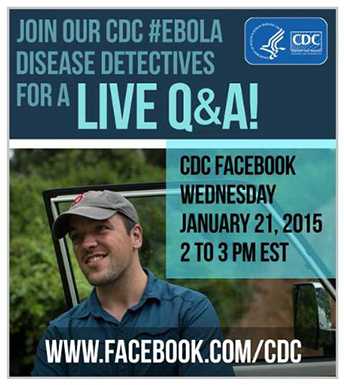
NCEZID staff remain a large part of the 2014-2016 West Africa Outbreak response both at home and abroad. As of January 26, there have been 13,702 laboratory-confirmed cases and 8,818 probable, suspected, and confirmed deaths reported in the hardest hit countries of Guinea, Liberia, and Sierra Leone. While the outbreak is still ongoing, recent case counts offer some hope that there will be an end, with each country reporting a decline in the growth of new cases.
No additional cases of Ebola have been reported in the United States, and entry screening and post-arrival monitoring is no longer in place for travelers coming from Mali, although it continues for Guinea, Liberia, and Sierra Leone. CDC teams have been hard at work helping our country’s healthcare system prepare for any possible future cases, including completing training for Ebola treatment centers and focusing on assessment hospitals that can safely receive, isolate, test, and care for an Ebola patient for up to 5 days until a diagnosis can be confirmed or ruled out and until discharge or transfer is completed.
In our continuing efforts to keep the public engaged and informed about the Ebola response, CDC held a Facebook Q&A featuring four NCEZID staff involved in various areas of the response. They responded to scores of questions and reached 13,264,277 individuals.
Listeriosis linked to caramel apples

A Listeria outbreak affected at least 32 people in 11 states between October and December 2014. Seven of those people died. Using whole genome sequencing, CDC was able to identify the illnesses as a cluster 1 week faster than would have occurred with the older methods. CDC worked with state and local health departments, the US Food and Drug Administration, and industry to identify prepackaged caramel apples as the source of the outbreak. Investigation partners were then able to take action to inform the public and get caramel apples off the shelves to keep more people from becoming ill.
HAI Progress Report:First Snapshot of State Efforts to Prevent MRSA and Deadly C. diff Infections
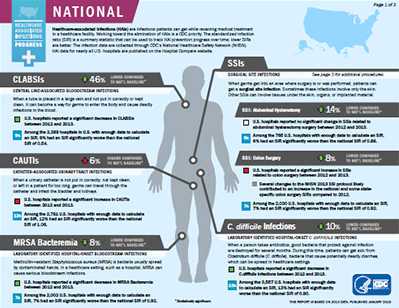
CDC’s National and State Healthcare-associated Infection Progress Report, just released this month, shows how each state and the country are doing in eliminating six types of infections that hospitals are required to report to CDC. More than 3000 hospitals reported on each of the measures. For the first time, the report provides a snapshot of state efforts to prevent MRSA and deadly C. diff infections.
States have made progress in eliminating infections that commonly threaten hospital patients, including a 46% decrease in central line-associated bloodstream infections (CLABSIs) from 2008 to 2013. More work is needed, however, to continue to improve patient safety.
Winner of “No-Petri-Dish” Challenge

The Office of Advanced Molecular Detection (AMD) recently encouraged research advances in culture-independent diagnostic testing through its “No-Petri-Dish” Diagnostic Test Challenge, announced through Challenge.gov. The competition challenged participants to describe a novel or innovative method to straintype and characterize pathogenic organisms directly from a complex clinical sample without the need for culture or culture-based amplification. Reference Genomics, Inc. won the $200,000 Challenge prize for their One Codex bioinformatics platform. The www.onecodex.com analysis platform can rapidly identify Shiga toxin-producing E. coli (STEC) from complex clinical samples and provide meaningful information about its strain type and characteristics, even when the pathogens are present at levels too low to support assembly-based methods. The winners will use the Challenge prize to continue developing the One Codex platform
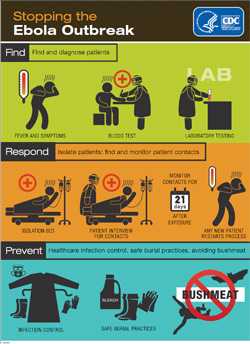
Since early spring 2014, teams from NCEZID, along with staff across CDC, have been working to stop the largest Ebola epidemic in history. Close to 300 NCEZID personnel have been deployed to West Africa to assist with response efforts, including surveillance, contact tracing, data management, laboratory testing, and health education. Hundreds of other NCEZID staff have been working in the Emergency Operations Center in Atlanta to provide technical expertise, logistics, staffing, communication, analytics, management, and other support functions for the response. Others have been partnering with US Customs and Border Protection to conduct enhanced entry screening at five US airports, including developing routine processes to identify travelers who show signs of infectious disease. Another important focus for many NCEZID staff has been on preparing US healthcare facilities to safely manage a patient with suspected Ebola virus disease.
The Road to Zero: CDC’s Response to the West African Ebola Epidemic

To commemorate the first year of the response, CDC released a multimedia report documenting the efforts of the agency and its partners in fighting the outbreak, told through the stories and photos of our responders. The website, video, and photobook offer a poignant look at how NCEZID and other CDC staff have contributed to this response over the past year.
- Page last reviewed: October 11, 2016
- Page last updated: October 11, 2016
- Content source:
Centers for Disease Control and Prevention
National Center for Emerging and Zoonotic Infectious Diseases (NCEZID)


 ShareCompartir
ShareCompartir
